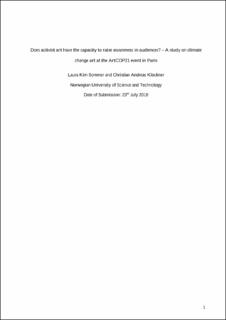| dc.contributor.author | Sommer, Laura K. | |
| dc.contributor.author | Kløckner, Christian | |
| dc.date.accessioned | 2022-11-18T09:18:45Z | |
| dc.date.available | 2022-11-18T09:18:45Z | |
| dc.date.created | 2021-01-14T11:56:24Z | |
| dc.date.issued | 2021 | |
| dc.identifier.citation | Psychology of Aesthetics, Creativity, and the Arts. 2021, 15 (1), 60-75. | en_US |
| dc.identifier.issn | 1931-3896 | |
| dc.identifier.uri | https://hdl.handle.net/11250/3032758 | |
| dc.description.abstract | The goal of this study was to investigate whether activist art can have a stimulating psychological effect on its spectators. This question is examined in art specifically related to climate change. With the aim of inspiring public engagement and communicating environmental issues to spark a climate change movement, ArtCOP21 is a global festival that took place simultaneously to the United Nations climate change negotiations (Conference of the Parties [COP21]) 2015 in Paris. Eight hundred seventy-four spectators responded to a questionnaire on their perception of 37 selected artworks. In an explorative study using cluster analysis, characteristics of the artworks were connected with emotional and cognitive audience responses. The analysis of the artworks assigned them to four clusters: “the comforting utopia,” “the challenging dystopia,” “the mediocre mythology,” and “the awesome solution.” As suggested by the name, the “awesome solution” was the cluster of artworks that caused the highest emotional and cognitive activation. Artists and environmental campaigners can use the commonalities of the artworks in this cluster in their own creative work and contribute to our understanding of the impact of activist art. | en_US |
| dc.language.iso | eng | en_US |
| dc.publisher | American Psychological Association | en_US |
| dc.title | Does activist art have the capacity to raise awareness in audiences? — A study on climate change art at the ArtCOP21 event in Paris. | en_US |
| dc.type | Peer reviewed | en_US |
| dc.type | Journal article | en_US |
| dc.description.version | acceptedVersion | en_US |
| dc.source.pagenumber | 60-75 | en_US |
| dc.source.volume | 15 | en_US |
| dc.source.journal | Psychology of Aesthetics, Creativity, and the Arts | en_US |
| dc.source.issue | 1 | en_US |
| dc.identifier.doi | 10.1037/aca0000247 | |
| dc.identifier.cristin | 1871250 | |
| cristin.ispublished | true | |
| cristin.fulltext | postprint | |
| cristin.qualitycode | 1 | |
